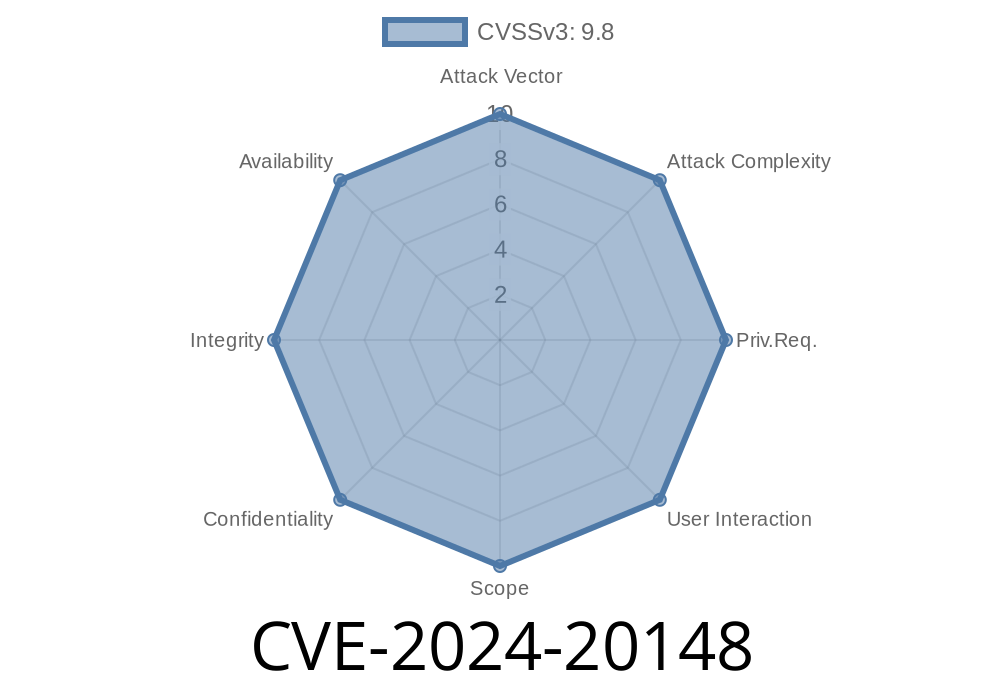In June 2024, a critical vulnerability identified as CVE-2024-20148 hit headlines in WiFi firmware. This long-form post breaks down the bug, how it’s exploited, and what to do if your device is at risk.
🔍 What is CVE-2024-20148?
CVE-2024-20148 is a vulnerability in WLAN (WiFi) Station (STA) Firmware found in certain chipsets and devices from major vendors. It occurs due to improper input validation, leading to an out of bounds write. This can allow attackers, who are physically close enough to you (proximal/adjacent network), to execute their code on your device — no interaction needed and no extra privileges required.
- Patch ID: WCNCR00389045 / ALPS09136494
⚠️ Why Does It Matter?
- Remote Attack Vector: Someone can attack you just by being close (like, at the same coffee shop).
No User Action Needed: Just having WiFi turned on is enough.
- Potential Damage: Attackers can gain execution on your device, install malware, surveil traffic, or pivot to deeper system attacks.
Where’s the Bug?
The issue is in the WiFi STA firmware:
When processing certain WiFi frames, the firmware does not check if the incoming data length is valid before copying data into fixed-sized buffers. This allows out of bounds (OOB) memory write — which is the first step in making the firmware do something it shouldn’t.
Suppose the code does something like
#define MAX_BUF_SIZE 256
void handle_wifi_frame(uint8_t *data, size_t len) {
uint8_t buf[MAX_BUF_SIZE];
// BAD: No check if len <= MAX_BUF_SIZE
memcpy(buf, data, len);
}
Here, if an attacker crafts a WiFi frame with len much larger than MAX_BUF_SIZE, the copy operation overwrites memory beyond buf, corrupting firmware structures — and sometimes allowing them to redirect execution.
Attacker: Needs to be near the victim (like in WiFi range).
- Victim Device: Has vulnerable WiFi firmware (chipset/driver not yet patched).
Attacker Sets Up a Malicious WiFi Device: Like a Raspberry Pi running some WiFi stack.
2. Crafts Malicious Frame: The attacker sends a special WiFi management or data frame, with embedded shellcode and an illegal length value.
3. Victim’s WiFi Chip Receives Frame: Firmware doesn’t check the size properly and does an OOB write.
4. Attacker’s Code Executes: The overwritten pointers or return addresses in firmware now point to the attacker's payload — maybe doing things like opening backdoors, reading memory, or even bricking the device.
(Simplified Python snippet to generate an evil frame)
import scapy.all as scapy
# Construct a WiFi beacon with a huge IE field (bad length)
payload = b'\x90' * 512 # Dummy shellcode/payload
frame = scapy.RadioTap() / \
scapy.Dot11(type=, subtype=8, addr1='ff:ff:ff:ff:ff:ff', addr2='12:34:56:78:9A:BC', addr3='12:34:56:78:9A:BC') / \
scapy.Dot11Beacon() / \
scapy.Dot11Elt(ID=221, info=payload)
scapy.sendp(frame, iface="wlanmon", count=1)
*This is oversimplified; real exploits need knowledge of precise chip/firmware details and may require more work to align the payload.*
Apply Patches!
- If your vendor lists WCNCR00389045 / ALPS09136494 as a patch, install it immediately.
- Check for advisory from your phone/laptop OEM:
- Many vendors will reference CVE-2024-20148 or mention the Patch/Issue ID.
National Vulnerability Database:
MediaTek Security Bulletin:
June 2024 Security Bulletin (MSV-1796)
Android Security Advisories:
Android Security Bulletin — June 2024
Example Scapy Usage for WiFi Frames:
✍️ Summary
CVE-2024-20148 is a “no click, no privilege” bug in WiFi firmware. It allows attackers nearby to remotely run code on your device by sending evil WiFi frames. If you’re a user, update your device ASAP. If you’re a developer, double-check all your length checks before memory copies — in embedded devices, those bugs still kill.
Stay safe out there — the airwaves aren’t as safe as you think!
Timeline
Published on: 01/06/2025 04:15:07 UTC
Last modified on: 01/06/2025 15:15:12 UTC
